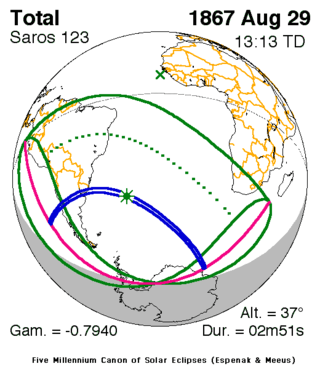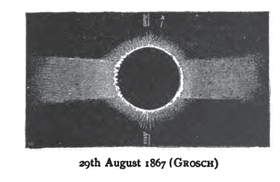Solar eclipse of August 29, 1867
| Solar eclipse of August 29, 1867 | |
|---|---|
 Map | |
| Type of eclipse | |
| Nature | Total |
| Gamma | -0.794 |
| Magnitude | 1.0344 |
| Maximum eclipse | |
| Duration | 171 sec (2 m 51 s) |
| Coordinates | 41°06′S 34°54′W / 41.1°S 34.9°W |
| Max. width of band | 189 km (117 mi) |
| Times (UTC) | |
| Greatest eclipse | 13:13:07 |
| References | |
| Saros | 123 (45 of 70) |
| Catalog # (SE5000) | 9205 |
A total solar eclipse occurred on August 29, 1867. A solar eclipse occurs when the Moon passes between Earth and the Sun, thereby totally or partly obscuring the image of the Sun for a viewer on Earth. A total solar eclipse occurs when the Moon's apparent diameter is larger than the Sun's, blocking all direct sunlight, turning day into darkness. Totality occurs in a narrow path across Earth's surface, with the partial solar eclipse visible over a surrounding region thousands of kilometres wide. Totality occurred across central Argentina and the southern Atlantic ocean.
Observations

José J. Vergara and Luis Grosch observed the eclipse from a small hill close to Santiago.[1]
Related eclipses
It is a part of solar Saros 123.
References
- ↑ L. Grosch. "Beobachtung der Sonnenfinsterniss am 29. August 1867.". Astronomische Nachrichten. 73: 137–138. Bibcode:1869AN.....73..137G. doi:10.1002/asna.18690730903.
- NASA chart graphics
- Total Eclipses of the Sun by Mabel Loomis Todd, 1900
| Wikimedia Commons has media related to Solar eclipse of 1867 August 29. |
This article is issued from Wikipedia - version of the 10/20/2016. The text is available under the Creative Commons Attribution/Share Alike but additional terms may apply for the media files.
